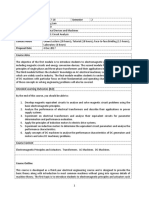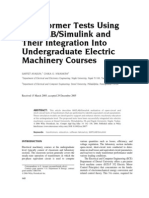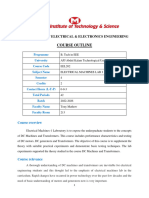EECE 470L - Electric Machines Laboratory: The Objectives of This Course Are To: Correlates To Program Objectives
EECE 470L - Electric Machines Laboratory: The Objectives of This Course Are To: Correlates To Program Objectives
Uploaded by
Quyen NguyenCopyright:
Available Formats
EECE 470L - Electric Machines Laboratory: The Objectives of This Course Are To: Correlates To Program Objectives
EECE 470L - Electric Machines Laboratory: The Objectives of This Course Are To: Correlates To Program Objectives
Uploaded by
Quyen NguyenOriginal Title
Copyright
Available Formats
Share this document
Did you find this document useful?
Is this content inappropriate?
Copyright:
Available Formats
EECE 470L - Electric Machines Laboratory: The Objectives of This Course Are To: Correlates To Program Objectives
EECE 470L - Electric Machines Laboratory: The Objectives of This Course Are To: Correlates To Program Objectives
Uploaded by
Quyen NguyenCopyright:
Available Formats
EECE 470L – Electric Machines Laboratory
Catalog description:
EECE 470L is a laboratory 1- credit course designed as a supplement to the Electric Machines (EECE 370) course.
The course covers practical experiment on transformers: open circuit, short circuit, and load test; unbalanced
loading and parallel operation of transformers; speed control and load characteristics of shunt, series and
compound DC machines; induction machines: blocked rotor, no-load, and loading tests; operation of single-phase
induction motors; operation of a synchronous machine connected to a large external source.
Credit hours: 1 credit
Required or elective: Elective for ECE and CCE students
Prerequisites: By course: EECE 370, By topic: Calculus, differential equations, and electric and magnetic circuit
analysis. Knowledge of KCL and KVL and ability of analyzing Electric Circuits. Basic computer simulation skills
using Matlab.
Textbook(s) and/or required materials: Experiment Manuals - Provided by the instructor
Electric Machinery Fundamentals, S. Chapman, 4th Edition, Mc Graw Hill, 2005
References:
− None
Computer usage: Word Processing for report writing and Matlab or LabVIEW for analysis.
Course Objectives
Correlates to
The objectives of this course are to: program
objectives
Information to supplement to the Electric Machines (EECE370) course. 1,2
The ability to conduct testing and experimental procedures on different types of
1,2,3
electrical machines.
A chance to practice different types of wiring and devices connections. 1,2,3
The capability to analyze the operation of electric machines under different loading
1,2,3,4
conditions
Course Topics
150min.
No. Subjects covered
lectures
1 Three Phase Transformers No-Load test, short circuit test and load test. 3
Unbalanced loading. Various connection and parallel operation.
2 DC Motors Series Motor Shunt Motor Compound Motor 3
3 − DC Generator Shunt Cumulative, and Differential Compound 1
4 Single and Three Phase Induction Motor Load Characteristics Starting current 2
and starting torque Equivalent circuit
5 Synchronous Motors/Generators Open circuit, short circuit characteristics, and 1
the regulation “V” curves
Course Learning Outcomes
Correlates to program outcomes*
At the end of the course, students should be able to:
H M L
Understand the concept of efficiency and the short circuit
impedance of a three-phase transformer from no-load test, winding (a),(b),(k) (d)(e)(n)
resistance, short circuit test, and load test.
Understand the effect of unbalanced loading on a three-phase
transformer with different connections, and the effects and (a),(b),(k) (d)(e)(n)
limitations of each connection.
Study series and parallel connections of three-phase transformers. (a),(b), (k) (d)(e)(n)
Understand the starting and connecting procedures of synchronous
(a),(b),(k) (d)(e)(n)
generators, and to obtain the ‘V’ curves of synchronous motors.
Experimentally obtain the load characteristics of various dc
(a),(b) (d)(e)(n)
motors and generators.
Experimentally obtain the load characteristics, starting current and
starting torque of a squirrel-cage induction motor and to derive (a),(b),(k) (d)(e)(n)
circuit parameters from no-load and blocked-rotor tests.
* H: High correlation, M: Medium correlation, L: Low correlation
Class/laboratory schedule: One 150-minute lab session per week.
Evaluation methods
1. Drop Quizzes: 20%
2. Experimental results and Lab Report: 30%
3. Final (open book/notes): 50%
Professional component
Engineering topics: 80%
General education: 10%
Mathematics and basic sciences: 10%
Person(s) who prepared this description and date of preparation
Prepared by Ghassan Dib on April 2009
Date of last revision
Revised by Dr. Karaki on April 2009
You might also like
- Hyd System - Part 1 Single Lift Pump ( - A - Batt. Comp.) (35,1.6, RR) (02.0-14.0-013)No ratings yetHyd System - Part 1 Single Lift Pump ( - A - Batt. Comp.) (35,1.6, RR) (02.0-14.0-013)6 pages
- EE3010 Electrical Devices and Machines - OBTLNo ratings yetEE3010 Electrical Devices and Machines - OBTL6 pages
- LAB - MANNUAL - BEE151 - 2023 - 24 DR - Sunil Kumar ChaudharyNo ratings yetLAB - MANNUAL - BEE151 - 2023 - 24 DR - Sunil Kumar Chaudhary45 pages
- Course Code Course Name Teaching Scheme (Contact Hours) Credits Assigned Theory Pract. Tut. Theory Tut. Pract. TotalNo ratings yetCourse Code Course Name Teaching Scheme (Contact Hours) Credits Assigned Theory Pract. Tut. Theory Tut. Pract. Total4 pages
- Energy Conversion Laboratory Lab ManualNo ratings yetEnergy Conversion Laboratory Lab Manual49 pages
- Introduction To Electrical Engineering LabNo ratings yetIntroduction To Electrical Engineering Lab2 pages
- Co-Requisite: Prerequisite: Data Book / Codes/Standards Course Category Course Designed by ApprovalNo ratings yetCo-Requisite: Prerequisite: Data Book / Codes/Standards Course Category Course Designed by Approval1 page
- Electrical Engineering Lab (2 Year Chemical)No ratings yetElectrical Engineering Lab (2 Year Chemical)23 pages
- Institute of Industrial Electronics Engineering, (Pcsir) KarachiNo ratings yetInstitute of Industrial Electronics Engineering, (Pcsir) Karachi11 pages
- February 18, 2011 - 802302-3 CIRCUIT ANALYSIS-II - 1431-1432 - Term 2 - Syllabus - ABET - Dr. Mohsen MahroosNo ratings yetFebruary 18, 2011 - 802302-3 CIRCUIT ANALYSIS-II - 1431-1432 - Term 2 - Syllabus - ABET - Dr. Mohsen Mahroos2 pages
- 3rd-4th Semester Detailed Syllabus - EENo ratings yet3rd-4th Semester Detailed Syllabus - EE30 pages
- Final Lab Manuel - EEE221L - Summer 2024 - 5 May 2024No ratings yetFinal Lab Manuel - EEE221L - Summer 2024 - 5 May 202429 pages
- Fundamental and Machine 4 Industrial BIT New Course GuidebookNo ratings yetFundamental and Machine 4 Industrial BIT New Course Guidebook4 pages
- Electrical Engineering Lab IV Course OutlineNo ratings yetElectrical Engineering Lab IV Course Outline4 pages
- Course Title: Elements of Power System Credit Units: 03 Course CodeNo ratings yetCourse Title: Elements of Power System Credit Units: 03 Course Code4 pages
- k12 Curriculum Guides Teched Unit-2 rst3205 ElectronicsNo ratings yetk12 Curriculum Guides Teched Unit-2 rst3205 Electronics54 pages
- Electrical Machines I F 3 PG DECEMBER 2016No ratings yetElectrical Machines I F 3 PG DECEMBER 20166 pages
- Consolidated 4th Sem Scheme and Syllabus Updated0No ratings yetConsolidated 4th Sem Scheme and Syllabus Updated015 pages
- Electrical Engineering Technology Higher National Diploma HND Machine CoursesNo ratings yetElectrical Engineering Technology Higher National Diploma HND Machine Courses13 pages
- EE4533 Power Apparatus and System Protection - OBTL100% (1)EE4533 Power Apparatus and System Protection - OBTL6 pages
- Power Electronics: Lecture Notes of Power Electronics CourseFrom EverandPower Electronics: Lecture Notes of Power Electronics CourseNo ratings yet
- Electrical Machines: Lecture Notes for Electrical Machines CourseFrom EverandElectrical Machines: Lecture Notes for Electrical Machines CourseNo ratings yet
- Generation and Transmission of Electric Power: Lecture Notes of the Generation and Transmission of Electric Power CourseFrom EverandGeneration and Transmission of Electric Power: Lecture Notes of the Generation and Transmission of Electric Power CourseNo ratings yet
- Methods for Increasing the Quality and Reliability of Power System Using FACTS DevicesFrom EverandMethods for Increasing the Quality and Reliability of Power System Using FACTS DevicesNo ratings yet
- Impedance Spectroscopy: Theory, Experiment, and ApplicationsFrom EverandImpedance Spectroscopy: Theory, Experiment, and ApplicationsEvgenij BarsoukovNo ratings yet
- Algorithmic Composition With Python and Music21 - Tutorial 01100% (1)Algorithmic Composition With Python and Music21 - Tutorial 015 pages
- Gr.11 Life Sciences Remote Learning Workbook Term 2 - RevisionNo ratings yetGr.11 Life Sciences Remote Learning Workbook Term 2 - Revision29 pages
- Electric Actuators 1.0 KN .: MC103 FeaturesNo ratings yetElectric Actuators 1.0 KN .: MC103 Features3 pages
- 1919 - Hoxton - The Joule Thompson Effect For Air at Moderate Temperatures and Pressures PDFNo ratings yet1919 - Hoxton - The Joule Thompson Effect For Air at Moderate Temperatures and Pressures PDF42 pages
- Solved RRB JE 1st June 2019 Shift-3 Paper With SolutionsNo ratings yetSolved RRB JE 1st June 2019 Shift-3 Paper With Solutions39 pages
- Product Datasheet Product Datasheet LED CLAS A 60 FR 8.5 W/4000 K E27No ratings yetProduct Datasheet Product Datasheet LED CLAS A 60 FR 8.5 W/4000 K E274 pages
- F-16 Chip Resetter Operating InstructionsNo ratings yetF-16 Chip Resetter Operating Instructions6 pages
- 5 Tutorial Flight 3 - Radar Anti Ice EGPWSNo ratings yet5 Tutorial Flight 3 - Radar Anti Ice EGPWS45 pages
- Evaluation of Digital Photography From Model Aircraft For Remote Sensing of Crop Biomass and Nitrogen StatusNo ratings yetEvaluation of Digital Photography From Model Aircraft For Remote Sensing of Crop Biomass and Nitrogen Status21 pages

























































































